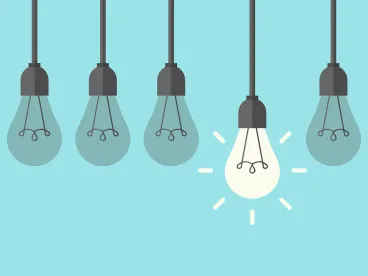RESEARCHERS CREATE NANOWIRE DEVICE THAT CAN GENERATE ELECTRICITY “OUT OF THIN AIR”
-
Scientists at the University of Massachusetts Amherst have developed a protein-based nanowire that produces an electrical current by absorbing water vapor from the atmosphere. Dubbed the “Air-gen” or “air-powered generator,” the device connects electrodes to innovative protein nanowires, and exposes the wires to ambient humidity. Because the nanowires possess a unique combination of electrical conductivity and surface chemistry, they generate a current between the two electrodes when exposed to ambient humidity.
-
The Air-gen devices are currently able to power small electronics, but the researchers’ ultimate goal is to develop large-scale energy systems. To scale the technology to commercial viability, the researchers plan to develop small Air-gen “patches” that can power wearable electronic devices such as fitness monitors and smart watches. The researchers also aim to produce Air-gens that can power cell phones, thus eliminating the need for periodic charging.
-
The Air-gen technology has advantages over other forms of renewable energy because it does not depend on variable factors such as wind or sunlight to generate electricity.
SHELL’S OFFSHORE WIND FARM WADES INTO DEEP WATERS FOR THE WORLD’S LARGEST GREEN HYDROGEN PROJECT
-
Shell has initiated feasibility work on an offshore wind farm designed to generate enough electricity to power the largest green hydrogen fuel project in the world. The green hydrogen facility will use water electrolysis to transform offshore wind electricity into “green” hydrogen to be used directly by industry or to be stored for later use.
-
Shell’s Netherlands affiliate is partnering with Gasunie, a Dutch gas grid operator, and the Port of Groningen to form the NortH2 Project to achieve the goal of meeting the Netherlands’ greenhouse gas emissions target under the Paris Agreement. The project is expected to produce 4 GW of offshore wind electricity in the North Sea by 2030 and 10 GW of offshore wind electricity by 2040. The facility is also predicted to generate 800,000 tons of green hydrogen annually, cutting emissions by seven megatons.
-
Shell’s pivot to green investment coincides with the early implementation of phase outs for internal combustion engine vehicles in some European countries. The Netherlands, for instance, has established a phase-out deadline of 2030. As a result of the NortH2 Project, many of the carbon taxes promulgated by European countries, like the Netherlands, may not be able to be levied on Shell and the other program participants.
EWF COMPLETES JOINT TEST OF RENEWABLES BLOCKCHAIN MARKET IN JAPAN
-
On February 27, 2020, the Energy Web Foundation (“EWF”) announced that it completed a joint test of a blockchain-based renewables marketplace with Minna Denryoku Co. Ltd. (“Minden”), a Japanese utility company. The test incorporated the Energy Web Chain and EWF’s software developer program, EW Origin, to assess Enection 2.0, a blockchain-based marketplace for renewables. Enection 2.0 matches sales of retail electricity with energy attribute certificates for renewable energy. The platform currently uses the New Economy Movement Blockchain.
-
The joint test (the “Minden-EWF Project”) tracked data from 16 renewable generators across Japan, including wind, hydro, biomass, and photovoltaic solar. The Minden-EWF Project also followed one month of 30-minute demand data from 13 specific energy consumers. The EWF programs used Minden’s customer tracker to follow the generation and demand for renewable energy based on various criteria like location and price. According to EWF, the experience affirmed the ability of EW Origin software development, while providing EWF new insights for meeting the regulatory and business needs of Japan’s energy market.
UNIVERSITY OF BRITISH COLUMBIA ENGINEERS COMBINE MICROGRIDS AND LOW-POWER SYSTEMS TO REDUCE BLACKOUTS
-
Researchers at the University of British Columbia have designed a new electric grid system concept that may reduce blackouts. The proposed grid system would consist of many microgrids that could be disconnected from one another and operate independently, thereby minimizing the risk of avoid widespread brownouts or blackouts. In the event of a potential power shortage, the disconnected microgrids would distribute energy to specific geographical areas at a diluted level relative to the fully connected grid. In other words, each microgrid would be able to provide its own (albeit diluted) electricity, thereby providing power to a select geographical area in case of a system failure or planned shutoff of the main system.
-
Larger grid systems have built-in safeguards that prioritize the transmission of power according to need so that hospitals and similarly important institutions receive power in the event of a shortage. Such safeguards create a tradeoff between power for some areas and not for others. These researchers believe their new design would not require such a choice by allowing power to flow for longer periods of time.
THINK TANK ENVISIONS ARTIFICIAL INTELLIGENCE SOLUTIONS TO COMBAT CLIMATE CHANGE
-
Climate Change AI, a not-for-profit organization composed of academics and energy industry players, has developed a collaborative space to share innovative practice and strategies to fight against climate change using advanced technology. Recently, the organization published its capstone paper detailing the role machine learning can play in addressing climate change. In addition to discussing how machine learning can be a powerful tool to reduce greenhouse gas emissions, the paper discusses the benefits of accelerating fusion science, forecasts supply and demand of electricity, offers climate-friendly construction solutions, estimates carbon stock, and predicts weather patterns.
-
By initiating collaboration between industry professionals with field experts, Climate Change AI seeks to leverage the best in adaptive technology to make energy generation, transmission, and consumption more efficient and effective.





 />i
/>i
